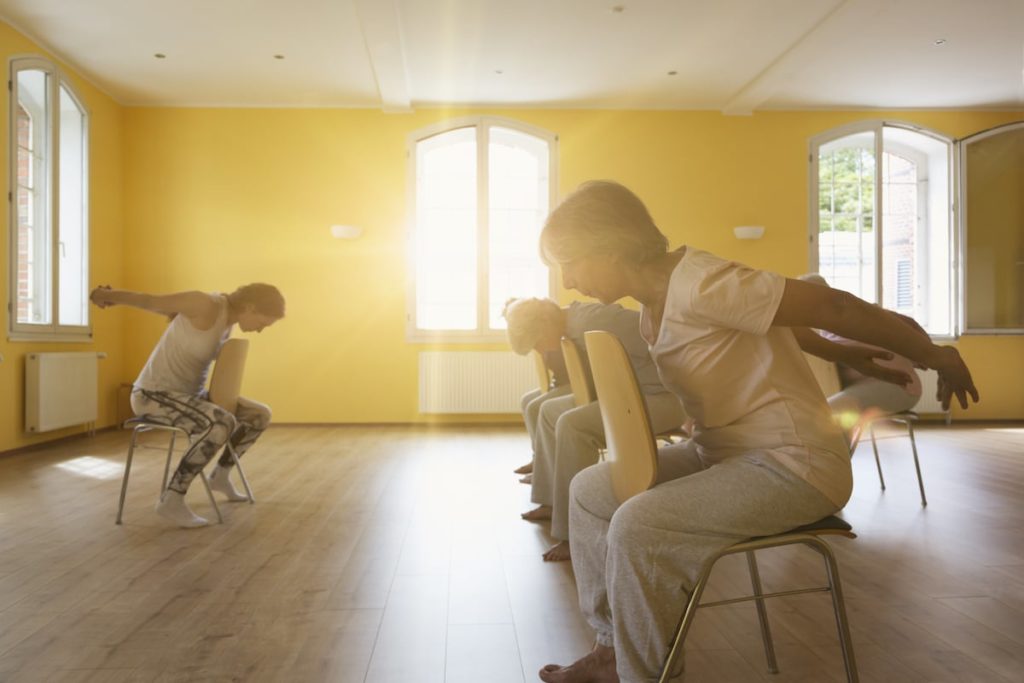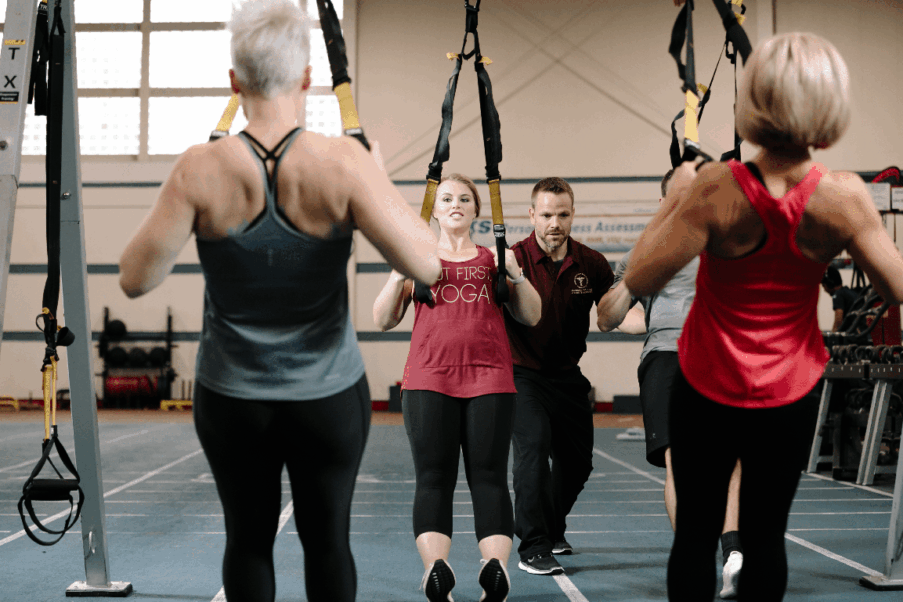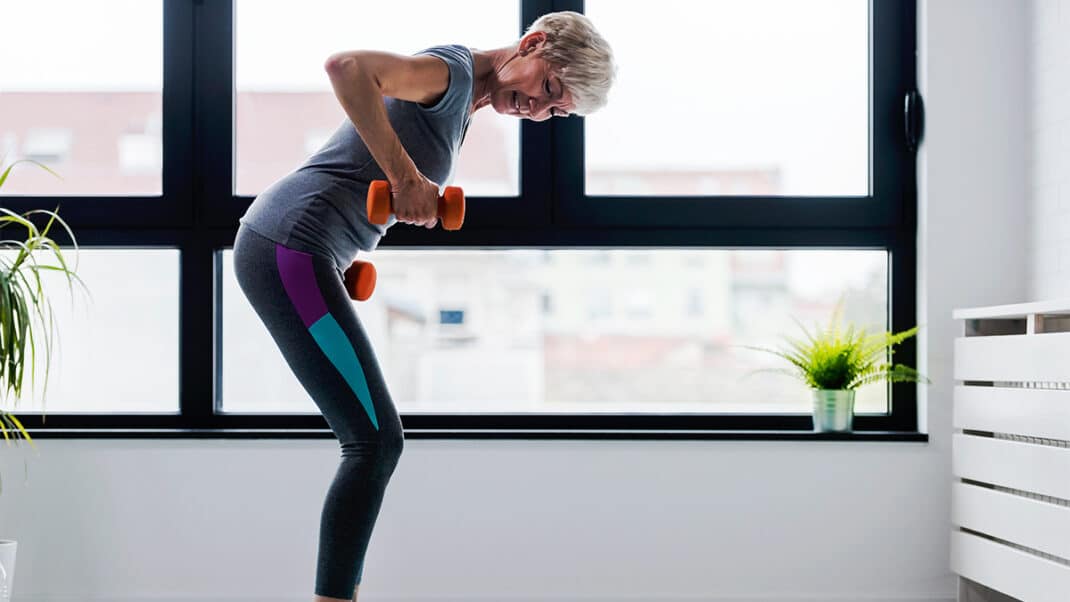Alzheimer’s and the Joy of Exercise
Creative exercise ideas for older adults with Alzheimer's disease.

Today, approximately 5.5 million adults in the United States have Alzheimer’s disease (AD). By the year 2030, people aged 65 or older will make up 20% of the country’s total population, and the number of adults with AD is projected to reach 8.4 million (Alzheimer’s Association 2017a).
For these adults and those with other types of dementia, the world of fitness is expanding to offer ample exercise possibilities, and there is a growing need for instructors to lead classes. As our population ages, it is prudent for fitness and wellness professionals to be familiar not only with normal, age-related biological changes but also with specific pathological conditions like dementia. Understanding its characteristics and knowing about nonpharmacological therapies can open pathways to providing comfort and joy for this subgroup of older adults.
This article offers an overview of helpful approaches and skills and then describes a basic chair fitness class for adults with AD.
Effective Nondrug Therapies
So far, there is no cure for AD, but research shows that the nonpharmacological therapies of exercise, cognitive stimulation and music therapy can improve quality of life (Alzheimer’s Association 2017b; Edasis 2015).
Exercise
Brain health is affected by the health of the heart and blood vessels, which together make up 2% of body weight and consume 20% of the body’s oxygen and energy supply (Alzheimer’s Association 2017a). Aerobic exercise helps keep the heart healthy, ensuring that enough oxygen-rich blood reaches the brain (Alzheimer’s Association 2017a). Strength and flexibility exercises assist with activities of daily living and reduce the risk of falling. Whether participants are ambulatory or not, focusing on strengths rather than limitations encourages a general sense of well-being (Best-Martini & Botenhagen-DiGenova 2003).
Cognitive Stimulation
Scientists around the world have found that the human brain is highly plastic, capable not only of creating new neurons but also of modifying existing networks of neurons to better cope with new circumstances. These discoveries are paving the way for greater understanding of conditions like AD (Dementia Today 2013).
One model based on the science of neuroplasticity shows promise for stabilizing and slowing cognitive decline. The New England Cognitive Center has developed a suite of cognitive programs that address attention, reaction time, visual spatial acuity, language and memory (Buchanan & Said 2016).
Music Therapy
We know from experience that music can lift the spirit, but we may be less aware of the full range of music’s potential benefits. Studies have shown that music can engage broad areas of neural networks that activate emotional, motor and creative areas of the brain (Janata 2009; University of Jyväskylä 2011; Alluri et al. 2012). Music memory is so powerful that some physicians have begun using it to treat AD (Engel & Wright 2012). In his groundbreaking book, Musicophilia: Tales of Music and the Brain (Vintage 2007), neurologist Oliver Sacks, MD, wrote, “Music acts as a Proustian mnemonic, eliciting emotions and associations that have been long forgotten, giving patient access once again to moods and memories, thoughts and words that had seemingly been completely lost.” Sacks even observed that music can “wake up” the brain in clients with late-stage AD.
Other Promising Methods
Additional approaches that may benefit adults with AD include puppetry and creative play.
Puppetry
One of the oldest art forms for entertaining audiences of all ages, puppetry has demonstrable capacity for engaging older adults with AD by eliciting emotions that go beyond words and memory. Even in the later stages of the disease, when memory, words and relationships are affected, it is possible for people with dementia to express imagination, amusement, sensitivities and personal preferences by using puppets (Marshall 2013).
Karrie Marshall, author of Puppetry in Dementia Care (Jessica Kingsley 2013), describes how puppets can facilitate connections, including when relationships change or words fail. Puppets can stimulate memories, help participants celebrate life achievements, and promote self-
esteem and confidence. Near the end of life, they can also provide comfort as part of palliative care.
Wartburg, a senior-care center in Mount Vernon, New York, is one example of a facility that has explored puppet arts for AD patients by having participants build their own puppets and act in improvisational theater. Puppetry is now part of Wartburg’s Creative Aging and Lifelong Learning Program (Wartburg Undated).
Creative Play
In her seminal book, The Fountain of Age (Simon & Schuster 1993), Betty Friedan suggests we need to dispel the myth of aging as only decline and instead look at it as a new stage in the developmental life cycle with specific tasks. She quotes renowned psychiatrist Carl Jung, who wrote that late-stage development involves a re-examining and “rebirth” into a creative and “playful approach to life, using all the possibilities that life has to offer, not in an ego-dominated way, but as a creative artist” (Jung 1969).
Being creative can reduce stress and anxiety, boost self-confidence and improve overall health (Rodriguez & Craig 2009). Creative play is joyful, and joyful activities are easier to do because we are intrinsically motivated to participate (Engel & Grover 2012). Rodolfo Llinás, a professor of neuroscience at New York University, writes that what we call creativity has nothing to do with rationality; that creativity is not born out of reasoning (Sacks 2007). It seems sensible, therefore, to assume that encouraging and expressing creativity within a classroom structure is ideal for clients with AD.
Chair Fitness Class for Adults With AD
In the chair fitness class for older adults at Sonora at Splendido, a memory support facility in Oro Valley, Arizona, we integrate exercise, music therapy, cognitive play and puppetry. We focus on cognitive components from the New England Cognitive Center; adhere to safety tips from Exercises for Frail Elders by Elizabeth Best-Martini and Kim Botenhagen DiGenova (Human Kinetics 2003); and add a healthy dose of creativity. Participants sit in a circular formation.
The class includes these elements:
Warmup: Qigong
Borrowing exercises from qigong, we lightly slap the body, starting with clapping our hands, then adding slaps to our lap and sometimes progressing to tapping/slapping the chest, arms and abdominal area. Slap/clap exercises increase attention and learning through repetition (Best-Martini & Botenhagen-DiGenova 2003). These qigong exercises are ideal for waking up the peripheral body and for overall health (Bates Undated).
Balls and Water Bottles
To bolster muscular endurance and reduce stress levels, we press and squeeze play balls. We bounce and catch balls to practice reaction skills and throw balls into a large bin to help with visual acuity. Participants love to “make baskets,” and we ensure success by where we place the bin. Bottles filled with cool water act as dumbbells and feel good to hands sensitive with arthritis.
Old Favorites
We play and sing enjoyable, familiar songs popular from participants’ youth or midlife (e.g., Broadway musicals, cowboy tunes, Big Band). With these old favorites as background music, we do some structured movement, often singing or humming along as we exercise. Music memory forms most fully between the ages of 15 and 25, and with it, memories of time, place, emotional state and a sense of identity take shape (Engel & Wright 2012). We let the mood of the music hold sway, and try to avoid competing noises that could lead to sensory overload (e.g., television, loud talking, fans).
Singing With Puppets
After the movement portion of class, my puppet, Granny Goodheart, directs a sing-along. At this stage, we’re no longer exercising, but we may do some focused work on deep breathing to activate postural-support muscles. Remembering and singing songs from the group’s past brings a surprising number of participants to a new level of alertness. It is astonishing to watch a client who has been in a torpid state “wake up” in the middle of class and start singing. It feels miraculous, and there are smiles all around.
Puppets and Finish Lines®
Next we have fun jogging the memory by playing Finish Lines®, a game in which participants are given the start of a song lyric, poem, nursery rhyme or proverb and are challenged to complete the quote. Puppets act as the game-show hosts, keeping the “beginning lines” rolling. Clients develop a sense of camaraderie in helping each other “finish the lines,” and the expressions of self-efficacy are heartwarming. One client liked the puppets so much that he made his own soft sculptures of Wizard of Oz characters in art therapy.
If you like the idea of puppets but prefer not to invest in making or buying larger puppets, an inexpensive alternative is to make small hand puppets from socks, felt and glue, embellishing them in whatever ways you like. You can find short tutorials online.
Get Creative!
Finding inspiring ways to teach movement to adults with AD involves a variety of artistic possibilities, making it fun and rewarding for both teacher and participants. So, in your exercise class design, let your creative juices flow. Bring in provocative props like puppets, put your game-show hat on, delve into your retro vinyl records and sing as if you know what you’re doing! That is the new fitness for the older adult with AD.
Alzheimer’s disease is the most prevalent form of degenerative brain disease, comprising 60%–80% of all dementia cases. Dementia is a syndrome or group of symptoms involving nerve-cell degeneration that affects brain functioning. The most common symptom is a gradual decline in remembering new information. Other symptoms include changes in mood; a decline in problem-solving abilities; difficulties with language or word choice; and withdrawal from social groups (Alzheimer’s Association 2017a). Many times, symptoms also include slower gait and poor balance (Rose 2003).
Effective communication skills and cues (both verbal and visual) are integral to developing and leading a successful exercise class. Below is a partial list of communication and safety tips for teaching participants with AD and related dementias.
- Choose exercises that enhance current skills (instead of relying on carry-over skills from one class to the next).
- Build on exercises that highlight clients’ abilities and strengths.
- Use repetition to help with learning and retention.
- Include counting and clapping exercises to increase attention.
- Avoid overstimulation and misunderstanding; speak in a reassuring and calm voice.
- Rely on body language more than spoken words.
- Use exercises based on everyday movements (e.g., reaching, dancing, sweeping the floor) that will tap into long-term memory that’s still intact.
Although clients with AD may need more repetition and stronger verbal and visual cuing than other exercise participants, it is important not to stereotype by communicating in ways that overaccommodate. Patronizing talk (e.g., “That’s a good girl!”), secondary baby talk (e.g., using words like doggie and choo-choo instead of dog and train) and elderspeak (e.g., talking more LOUDLY, more s-l-o-w-y or with too much redundancy) are all examples of overaccommodation and can constrain an older adult’s sense of appropriateness (Harwood 2007).
References
Alluri, V., et al. 2012. Large-scale brain networks emerge from dynamic processing of musical timbre, key and rhythm. NeuroImage, 59 (4), 3677–89.
Alzheimer’s Association. 2017a. 2017 Alzheimer’s Disease Facts and Figures. Accessed May 1, 2017: www.alz.org/documents_custom/2017-facts-and-figures.pdf.
Alzheimer’s Association. 2017b. Music, art and Alzheimer’s. Accessed June 10, 2017: www.alz.org/care/alzheimers-dementia-music-art-therapy.asp.
Alzheimers.net. 2014. 5 reasons why music boosts brain activity. Accessed June 10, 2017: www.alzheimers.net/2014-07-21/why-music-boosts-brain-activity-in-dementia-patients.
Bates, R. Undated. Gentle exercises for optimal health: #4: Outer qi shower. Accessed Oct. 14, 2016: www.funwithqigong.com.
Best-Martini, E., & Botenhagen-DiGenova, K.A. 2003. Exercise for Frail Elders. Champaign, IL: Human Kinetics.
Buchanan J., & Said, P.C. 2016. Cognitive training to oppugn Alzheimer’s disease and dementia. Today’s Geriatric Medicine, 9 (6), 20.
Dementia Today. 2013. Brain plasticity and Alzheimer’s disease. Accessed June 10, 2017: www.dementiatoday.com/brain-plasticity-and-alzheimers-disease-2.
Edasis, C. 2015. Music and art in memory care. Accessed June 27, 2017: Today’s Geriatric Medicine, 8 (1), 10.
Engel, R., & Grover E.W. 2012. Oh, think of the possibilities! Creative thinking at work and play. www.matherlifewaysinstituteonaging.com/wp-content/uploads/2012/03/MLWOrangePaper_Creativity_2.pdf (no longer available). Accessed Mar. 20, 2017: www.matherlifeways.com/keys/KeystoAgingWell.pdf.(no longer available). Accessed Mar. 20, 2017: www.matherlifeways.com/keys/KeystoAgingWell.pdf.
Engel R., & Wright B. 2012. Take note(s): Living well through music. Accessed May 5, 2017: www.Matherlifewaysinstituteonaging.com/wp-content/uploads/2012/03/MLWOrangePaper_LivingWellThroughMusic_2.pdf (no longer available). Accessed Mar. 20, 2017: www.matherlifeways.com/keys/KeystoAgingWell.pdf.
Friedan, B. 1993. The Fountain of Age. New York: Simon & Shuster.
Harwood, J. 2007. Understanding Communication and Aging. Thousand Oaks: Sage Publications.
Janata, P. 2009. The neural architecture of music-evoked autobiographical memories. Cerebral Cortex, 19, 11, 254–55.
Jung, C.G. 1969. The stages of life. In Collected Works of C.G. Jung, vol. 8. Princeton, NJ: Princeton University Press.
Marshall, K. 2013. Puppetry in Dementia Care: Connecting Through Creativity and Joy. London: Jessica Kingsley Publishers.
Rodriguez, D. & Craig, C.W. 2009. Creativity can keep you healthy. Everyday Health. Accessed May 5, 2017: www.everydayhealth.com/emotional-health/understanding/creativity-productivity-and-leisure.aspx.
Rose, D.J. 2003. FallProof: A Comprehensive Balance and Mobility Training Program. Champaign, IL: Human Kinetics.
Sacks, O. 2007. Musicophilia: Tales of Music and the Brain. New York: Vintage Books.
University of Jyväskylä. 2011. Listening to music lights up the whole brain. Accessed Aug. 31, 2017: www.jyu.fi/en/news/archive/2011/12/tiedote-2011-12-05-12-41-32-030546.
Wartburg. Undated. Wartburg’s puppetry program helps Alzheimer’s & dementia patients. Accessed June 10, 2017: www.wartburg.org/wartburgs-puppetry-program-helps-alzheimers-dementia-patients.
Jeanne Missey Osgood, MA
Hello fitness enthusiasts, I have been teaching fitness since the mid 80's and certified with ACE since 1987; so I have been around for a long time. I have owned several fitness businesses over the past 25 years, worked in Luxembourg City, Luxembourg as a fitness specialist, worked as the Fitness Director of Campus Recreation at the University of Arizona and for The Academy Village retirement community. Currently, I own and operate a Pilates studio in Tucson called the Tucson Pilates Lab and offer a teacher training program for Pilates and other genres of movement for instructors learning how to teach called the Arizona Pilates Academy. I have created two DVD packages for instructor trainees, a chair fitness program for older adults called Total Fitness and Pilates Teacher Training, a 6 DVD, 2 CD package for learning both Mat Pilates and Pilates on the apparatus. You can find them on my website, totalfitnessllc.com.





